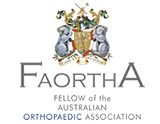
Resurfacing
Arthritis is a general term covering numerous conditions where the joint surface (cartilage) wears out. The joint surface is covered by a smooth articular surface that
allows pain free movement in the joint. This surface can wear out for a number of reasons; often the definite cause is not known. When the articular cartilage wears out, the bone ends rub on one another and cause pain.
There are numerous conditions that can cause arthritis and often the exact cause is never known. In general, but not always, it affects people as they get older and is called Osteoarthritis.
In an arthritic hip:
- The cartilage lining is thinner than normal or completely absent. The degree of cartilage damage and inflammation varies with the type and stage of arthritis.
- The capsule of the arthritic hip is swollen
- The joint space is narrowed and irregular in outline; this can be seen in an X-ray image.
- Bone spurs or excessive bone can also build up around the edges of the joint.
The combinations of these factors make the arthritic hip stiff and limit activities due to pain or fatigue.
Diagnosis
Hip conditions should be evaluated by an Orthopaedic surgeon for proper diagnosis and treatment.
Your surgeon will perform the following:
- Medical History
- Physical Examination
Diagnostic Studies may include:
- X-rays:a form of electromagnetic radiation that is used to take pictures of bones.
There is no blood test to diagnose osteoarthritis.
Surgical Procedure
The surgery will be performed using general, spinal or epidural anaesthesia. A combination of techniques is often used. The surgeon makes an incision along the affected hip joint, exposing the hip joint.
The femur is separated from the hipbone socket. The socket of the hip joint is exposed. It is reamed to a hemispherical surface and prepared to take the new cup (acetabular component). The new cup is a press-fit; the back of this cup is roughened to allow bone
to grow into it. The femur is then exposed and the femoral head is either trimmed or reamed down to an accurate shape to take its new metal component. The metal component is attached to the reshaped femur. This new metal ball will act like the hip joint’s original ball. Then the new ball and the new socket components are joined together to form the new hip joint. The muscles and tendons are then repaired and the skin is closed. Drains are usually inserted to drain excessive blood.
Post-op Precautions
Remember this is an artificial hip and must be treated with care. Avoid the combined movement of bending your hip and turning your foot in. This can cause dislocation. Other precautions to avoid dislocation are:
- You should sleep with a pillow between your legs for 6 weeks
- Avoid crossing your legs and bending your hip past a right angle
- Avoid low chairs
- Avoid bending over to pick things up. Grabbers are helpful as are shoe horns or slip on shoes
- An elevated toilet seat is helpful
- You can shower once the wound has healed.
- You can apply Vitamin E or moisturizing cream into the wound once the wound has healed.
- If you have increasing redness or swelling in the wound or temperatures over 100.5° you should call your doctor.
- If you are having any procedures such as dental work or any other surgery you should take antibiotics before and after to prevent infection in your new prosthesis. Consult your surgeon for details.
- Your hip replacement may go off in a metal detector at the airport.
Risks and complications
As with any major surgery, there are potential risks involved. The decision to proceed with the surgery is made because the advantages of surgery outweigh the potential disadvantages. It is important that you are informed of these risks before the surgery takes place.
Complications can be medical (general) or specific to the hip
Medical complications include those of the anaesthetic and your general wellbeing. Almost any medical condition can occur so this list is not complete. Complications include
- Allergic reactions to medications
- Blood loss requiring transfusion with its low risk of disease transmission
- Heart attacks, strokes, kidney failure, pneumonia, bladder infections
- Complications from nerve blocks such as infection or nerve damage
- Serious medical problems can lead to ongoing health concerns, prolonged hospitalization or rarely death.
Specific complications
- Infection
Infection can occur with any operation. In the hip this can be superficial or deep. Infection rates are approximately 1%. If it occurs, it can be treated with antibiotics but may require further surgery. Very rarely your hip may need to be removed to eradicate infection.
- Dislocation.
This means the hip comes out of its socket. Precautions need to be taken with your new hip forever. If a dislocation occurs it needs to be put back into place with an anaesthetic. Rarely this becomes a recurrent problem needing further surgery.
- Fractures (break) of the femur (thigh bone) or pelvis (hipbone)
This is also rare but can occur during or after surgery. This may prolong your recovery or require further surgery.
- Damage to nerves or blood vessels
Also rare but can lead to weakness and loss of sensation in part of the leg. Damage to blood vessels may require further surgery if bleeding is ongoing.
- Blood clots (Deep Venous Thrombosis)
These can form in the calf muscles and can travel to the lung (pulmonary embolism). These can occasionally be serious and even life threatening. If you get calf pain or shortness of breath at any stage, you should notify your surgeon.
- Wound irritation
Your scar can be sensitive or have a surrounding area of numbness. This normally decreases over time and does not lead to any problems with your new joint.
- Leg length inequality
It is very difficult to make the leg exactly the same length as the other one. Occasionally the leg is deliberately lengthened to make the hip stable during surgery. There are some occasions when it is simply not possible to match the leg lengths. All leg length inequalities can be treated by a simple shoe raise on the shorter side.
- Wear
All joints eventually wear out. The more active you are, the quicker this will occur. In general 80-90% of hips survive 15 years.
- Failure to relieve pain
Very rare but may occur especially if some pain is coming from other areas such as the spine.
- Unsightly or thickened scar
- Pressure or bed sores
- Limp due to muscle weakness












